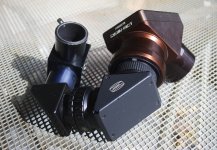henry link
Well-known member
I had a look at the Meopta website and their 2018 Sports Optics catalogue this morning. I left with a few questions, particularly about the S2 spotting scope.
The cutaway of the S2 angled version on page 38 of the catalogue shows a prism configuration quite unreadable to me. I've puzzled over it before, but a new description in the 2018 catalogue has this cryptic description: "A special system of 3 Porro prisms also provides the option of occasional astronomical observation". That statement suggests that perhaps the prism is an odd variant of a Porro Type 2 in which two of the three prisms are rotated in such a way that a 45º deviation results. That would be unique among spotting scopes, but if true it would have the advantage of not requiring mirror coatings compared to a Porro Semi-Pentaprism arrangement or phase correction compared to a Schmidt roof prism.
I also noticed that the objective lens in the website specs is described as 7 elements in 5 groups. I can't find all those elements in the cutaway. It looks like 4 or at most 5 in 3 groups unless maybe the prism is included as 3 elements in 2 groups.
Finally I noticed that Meopta has been using a superior multicoating they call Meolux on certain rifle scopes for several years, but for some reason has yet to introduce it on the binoculars or the S2 spotting scope, which still use the less transmissive Meobright. Why would they not use their best coating on their flagship products?
Anybody know anything about any of this? Maybe Lee could ask his contact at Meopta for some Enlightenment.
Henry
The cutaway of the S2 angled version on page 38 of the catalogue shows a prism configuration quite unreadable to me. I've puzzled over it before, but a new description in the 2018 catalogue has this cryptic description: "A special system of 3 Porro prisms also provides the option of occasional astronomical observation". That statement suggests that perhaps the prism is an odd variant of a Porro Type 2 in which two of the three prisms are rotated in such a way that a 45º deviation results. That would be unique among spotting scopes, but if true it would have the advantage of not requiring mirror coatings compared to a Porro Semi-Pentaprism arrangement or phase correction compared to a Schmidt roof prism.
I also noticed that the objective lens in the website specs is described as 7 elements in 5 groups. I can't find all those elements in the cutaway. It looks like 4 or at most 5 in 3 groups unless maybe the prism is included as 3 elements in 2 groups.
Finally I noticed that Meopta has been using a superior multicoating they call Meolux on certain rifle scopes for several years, but for some reason has yet to introduce it on the binoculars or the S2 spotting scope, which still use the less transmissive Meobright. Why would they not use their best coating on their flagship products?
Anybody know anything about any of this? Maybe Lee could ask his contact at Meopta for some Enlightenment.
Henry





